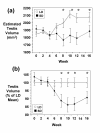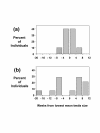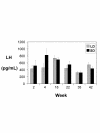Reduced body mass, food intake, and testis size in response to short photoperiod in adult F344 rats
- PMID: 12135532
- PMCID: PMC122066
- DOI: 10.1186/1472-6793-2-11
Reduced body mass, food intake, and testis size in response to short photoperiod in adult F344 rats
Abstract
Background: Although laboratory rats are often considered classic nonseasonal breeders, peripubertal rats of two inbred strains, F344 and BN, have both reproductive and nonreproductive responses to short photoperiods. Unmanipulated adult rats have not been reported to have robust responses to short photoperiod alone, although several treatments can induce photoperiodic responses in adults. In this study, we tested the hypotheses that unmanipulated F344 rats retain responses to short photoperiod as adults and that they have the necessary elements for an endogenous circannual rhythm of sensitivity to short photoperiod.
Results: Relative to rats kept in long photoperiods (L16:D8), adult F344 rats transferred at 4.5 months of age to short photoperiods (L8:D16) had significantly lower testis size, food intake, and body weight. In a second experiment, newly weaned F344 rats underwent an initial period of inhibition of reproductive maturation, lower food intake, and lower body weight in short photoperiod or intermediate photoperiod (L12:D12) relative to rats in long photoperiod. By 18 weeks of treatment, rats in the two inhibitory photoperiods no longer differed from long photoperiod controls. In short photoperiod, rats underwent a second period of slight reproductive inhibition between weeks 35 and 48, but there was an effect on body weight and slight inhibition of food intake only in an intermediate photoperiod.
Conclusion: Male F344 rats retain photoresponsiveness as adults, with less reproductive inhibition but equivalent nonreproductive responses. There was only weak evidence for an endogenous timer controlling a circannual cycle of sensitivity to short photoperiod.
Figures







Similar articles
-
Genetic variation in photoperiodism among naturally photoperiodic rat strains.Am J Physiol Regul Integr Comp Physiol. 2001 Dec;281(6):R1817-24. doi: 10.1152/ajpregu.2001.281.6.R1817. Am J Physiol Regul Integr Comp Physiol. 2001. PMID: 11705766
-
Reproductive photoresponsiveness in unmanipulated male Fischer 344 laboratory rats.Biol Reprod. 1997 Jul;57(1):134-8. doi: 10.1095/biolreprod57.1.134. Biol Reprod. 1997. PMID: 9209091
-
Short photoperiod inhibition of growth in body mass and reproduction in ACI, BUF, and PVG inbred rats.Reproduction. 2004 Dec;128(6):857-62. doi: 10.1530/rep.1.00390. Reproduction. 2004. PMID: 15579603
-
Photoperiodic control of seasonality in birds.J Biol Rhythms. 2001 Aug;16(4):365-80. doi: 10.1177/074873001129002079. J Biol Rhythms. 2001. PMID: 11506381 Review.
-
Endocrine and testicular changes associated with season, artificial photoperiod, and the peri-pubertal period in stallions.Vet Clin North Am Equine Pract. 1992 Apr;8(1):31-56. doi: 10.1016/s0749-0739(17)30465-0. Vet Clin North Am Equine Pract. 1992. PMID: 1576553 Review.
Cited by
-
Cherries with Different Geographical Origins Regulate Neuroprotection in a Photoperiod-Dependent Manner in F344 Rats.Antioxidants (Basel). 2024 Jan 3;13(1):72. doi: 10.3390/antiox13010072. Antioxidants (Basel). 2024. PMID: 38247496 Free PMC article.
-
Absence of circadian and photoperiodic conservation of energy expenditure in three rodent species.J Comp Physiol B. 2007 Apr;177(3):309-18. doi: 10.1007/s00360-006-0130-7. Epub 2006 Nov 29. J Comp Physiol B. 2007. PMID: 17136546
-
Histo-morphological and seminal evaluation of testicular parameters in diabetic rats under antiretroviral therapy: interactions with Hypoxis hemerocallidea.Iran J Basic Med Sci. 2018 Dec;21(12):1322-1330. doi: 10.22038/ijbms.2018.25046.6213. Iran J Basic Med Sci. 2018. PMID: 30627378 Free PMC article.
-
Effects of empagliflozin on the expression of kisspeptin gene and reproductive system function in streptozotocin-induced diabetic male rats.Front Endocrinol (Lausanne). 2022 Nov 21;13:1059942. doi: 10.3389/fendo.2022.1059942. eCollection 2022. Front Endocrinol (Lausanne). 2022. PMID: 36479221 Free PMC article.
-
Photoperiodic effects on seasonal physiology, reproductive status and hypothalamic gene expression in young male F344 rats.J Neuroendocrinol. 2015 Feb;27(2):79-87. doi: 10.1111/jne.12241. J Neuroendocrinol. 2015. PMID: 25443173 Free PMC article.
References
-
- Bronson FH, Heideman PD. Seasonal regulation of reproduction in mammals. In: E Knobil, JD Neill, editor. Seasonal regulation of reproduction in mammals. Raven Press; 1994.
-
- Gwinner E. Circannual Rhythms. Berlin: Springer-Verlag. 1986.
-
- Sizonenko PC, Lang U, Rivest RW, Aubert ML. The pineal and pubertal development. Ciba Foundation Symposium: Photoperiod, melatonin and the pineal. 1985;117:208–230. - PubMed
-
- Leadem CA. Photoperiodic sensitivity of prepubertal female Fisher 344 rats. J Pineal Res. 1988;5:63–70. - PubMed
-
- Heideman PD, Sylvester CJ. Reproductive photoresponsiveness in unmanipulated Fischer 344 laboratory rats. Biol Reprod. 1997;57:134–138. - PubMed
Publication types
MeSH terms
Substances
Grants and funding
LinkOut - more resources
Full Text Sources
Medical

